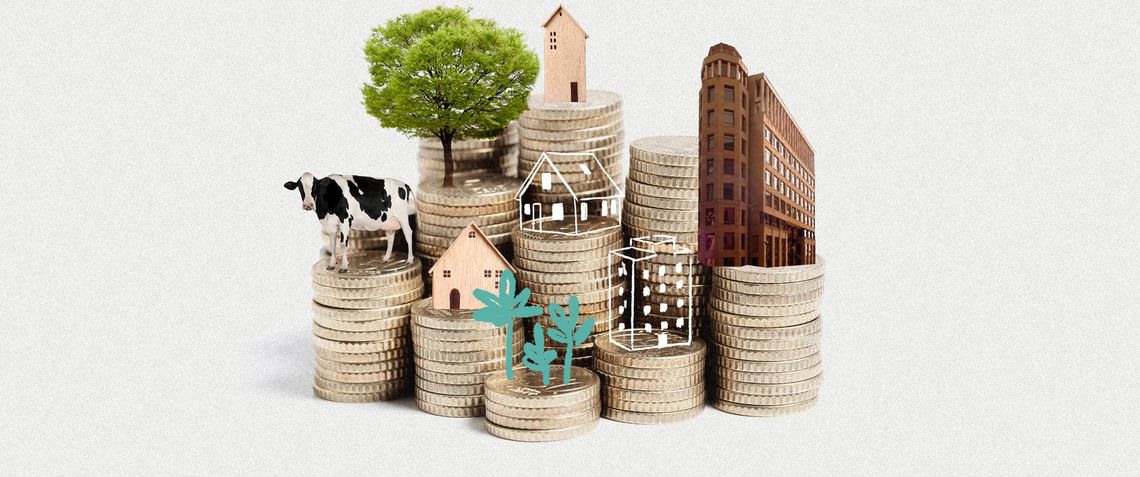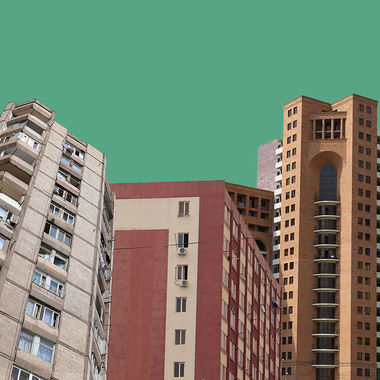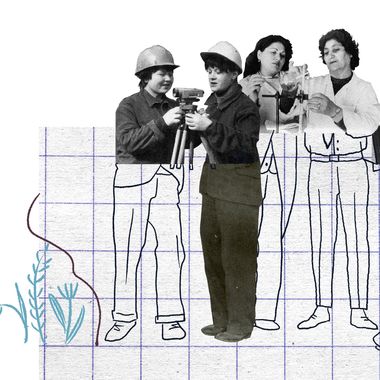
Illustration by Armine Shahbazyan.
For any country’s economy, the real estate market is a key element of national wealth. The real estate market is important for several reasons, such as the need to meet the demand for residential and non-residential buildings, its share in the country’s GDP, its multiplying effect on related sectors of the economy and other factors. The construction sector also has a great impact. According to expert calculations, one job position in the construction sector creates nine additional jobs in other economic sectors.
Also, the real estate market reflects the real situation and issues the economy is facing. It is influenced by the economy’s real and financial sectors because, in this market, supply and demand are dependent on the country’s economic and financial situation.
To understand the issues Armenia’s real estate market faces, we have to first and foremost take a look at statistics. According to its 2020 annual report, Armenia’s Cadastre Committee recorded 158,600 total files last year. Files not only include resale and new build transactions, but also instances of changes in title due to inheritance or gifts, the registering of rental and lease agreements, the imposing of liens onto a property, etc. Among these, sales transactions provide the most insight into market trends. For example, sales figures were down 10.4% from 2019, at 46,159 compared to 51,508 the year prior. However, they remained slightly above the 2018 figure of 45,637. Of course, a decrease could be expected due to the global coronavirus pandemic and the 2020 Artsakh War interrupting the normal pattern. Yerevan makes up about a third of the market, with 13,899 sales last year, down 22% from 2019.
All categories of the Yerevan market were down except for empty land as shown below:
-
Residential apartments: 8,199 sales, down 26.9%
-
Residential houses: 1,610 sales, down 20.5%
-
Empty land: 1,518 sales, up 7.8%
-
Garage units: 1,435 sales, down 18.2%
-
Commercial units: 965 sales, down 21.2%
-
Industrial units: 172 sales, down 16.5%
Despite sales numbers going down, nominal prices (as expressed in AMD) continued to increase in Yerevan, at an average of 7.5% per square meter over 2019. It is important to consider, however, that the value of the AMD lost 8.9% against the USD over 2020 (mostly near the end of the year, after the ceasefire agreement that ended the 2020 Artsakh War). While the paperwork for real estate transactions legally must be spelled out in AMD, in practice, prices are quoted and paid in USD. Thus, real prices can be said to have experienced a slight overall decline. Average prices per square meter for an apartment in Yerevan’s different districts are shown below, along with the change compared to 2019:
-
Kentron: 644,800 AMD, up 6.2%
-
Arabkir: 452,000 AMD, up 8.9%
-
Davtashen: 355,200 AMD, up 5.1%
-
Kanaker-Zeytun: 328,500 AMD, up 7.3%
-
Ajapnyak: 313,600 AMD, up 9.6%
-
Shengavit: 300,000 AMD, up 8.8%
-
Avan: 295,600 AMD, up 7.9%
-
Nor Nork: 293,500 AMD, up 9.6%
-
Malatia-Sebastia: 289,600 AMD, up 8.7%
-
Erebuni: 288,200 AMD, up 6.5%
-
Nubarashen: 183,100 AMD, up 3.3%
There has been a shift from the resale market to newly-built buildings, which has to do with state support programs and income tax rebates meant to encourage new construction. However, the setback in 2020 cast doubts on whether planned projects will go ahead. If the downward trend in sales does not reverse, some construction companies could freeze or scale back their construction projects.
In the battle for buyers, developers have moved toward the more affordable end of the apartment unit market, where the majority of projects are being carried out through mortgage incentive programs. Price increases for building materials will also significantly impact the price of apartments.
The next trend in Armenia’s real estate market prior to the 2020 Artsakh War was the increase in the number of transactions for land parcels, especially agricultural land.This can be explained by state policies and programs aimed at developing intensive orchards, “smart” barns and greenhouses through interest-free or subsidized loans.
Another reason why the demand for land has grown has to do with new construction projects which are gradually moving from Kentron, Arabkir and Davtashen to the outskirts of the capital and into the neighboring regions.
The coronavirus pandemic and the war unleashed on Artsakh have also left a serious impact on Armenia’s real estate market. Specifically, mid-March to mid-May was spent in quarantine with cadastre offices closed, which resulted in a 12% decrease in the number of real estate sales transactions. Even after the quarantine was lifted, June 2020 saw a 1% decrease compared to June 2019, meaning any pent-up demand had evaporated. If the borders were left open, the situation in the real estate market could have developed in a completely different direction.
An increase in tourism after 2018 had led to a cottage industry of Airbnb-style short-term apartment rentals, as hotels failed to keep up with demand. Once the State of Emergency was declared in March 2020, however, foreign citizens were refused entry to the country and tourism stalled, leaving owners of short-term rental units in a tight situation, especially if they had purchased the property through loans.
The biggest decline in the Armenian real estate market was registered in the fourth quarter of 2020. Sales transactions dropped 30.5% from 15,643 in Q4 2019 to 10,879 in Q4 2020, as October to December was spent in full mobilization toward the war effort and then in shock over the ceasefire agreement and the extent of missing persons. The deterioration of the economic situation and uncertainty toward the future led to a so-called “savings paradox,” which has had a negative impact on consumption. However, in the long run, especially if the economy improves, this can turn into a moving force driving an increase in demand for apartments.
Another important factor is the rising property tax rate. Specifically, on June 25, 2020, the National Assembly passed Bill G-651, which foresees new higher property tax rates starting January 1, 2021, and phasing in over the next six years. Details of the decision are available in a previous EVN Report article.
It’s noteworthy that, during 2020, construction expenditures decreased by 9.5%, due to reduced activity by private construction companies, even while state expenditures on construction increased.
The halt in real estate activity in 2020 also held back bank loans. In December 2020, loan extensions amounted to 226 billion AMD, having doubled from March 2020. These are loans that had their payment deadlines extended by a mutual agreement between the banks and borrowers before the initial loan payment period expired. As a result, the share of loan extensions in the country’s loan profile reached 5.45%. At the beginning of the year, it was 3.08%. Under these conditions, banks clearly realize that especially expensive mortgaged properties can be very difficult to sell, leaving them at a potential loss if they foreclosed. If a large proportion of foreclosed properties were to hit the market at the same time, it would drive down prices even further, an impact which is not in the banks’ interests.
In conclusion, we should note that, due to the pandemic and the post-war situation, Armenia is witnessing a decline in purchasing power, a phenomenon that has a big impact on the real estate market. Uncertainty toward the future and a resurgence in emigration certainly don’t help either. These are creating additional risks and deteriorating the real estate market’s attractiveness.
State statistics show that prices in AMD have increased, even as sales have gone down, meaning that owning real estate is still a hedge against currency risk. More expensive properties (over $100,000) will be harder to sell, leading to downward price pressure at the higher end of the market if sellers remain motivated due to being squeezed financially. Meanwhile, prices for 1-3 bedroom apartments, small private homes and business spaces will stay the same or, even possibly, increase..
The decrease in private construction projects means that, during crisis situations, private companies and banks are not interested in adding investments in this direction. Taking into consideration the drastic decrease in the demand for large and expensive property, it’s quite possible that crisis investors will start to emerge in the market, who will seek to purchase these assets at comparably low prices with the aim of reselling them later at a profit. The summer 2021 season will be an important bellwether for the medium-term outlook.
also read
Property Tax Increases Expected to Reform an Obsolete Approach
By Astghik Karapetyan
Armenia’s parliament recently approved property tax increases that led to a wave of debate and blowback. Astghik Karapetyan explains how the reform is being implemented.
Buying Real Estate in Armenia: One Diasporan’s Experience
By Harout Manougian
Are you interested in purchasing a home in Yerevan? If so, Harout Manougian offers some invaluable information and advice and more importantly, tips on how to avoid the inevitable pitfalls in an unregulated real estate market.
Possessions That Remain in Documents and Photographs
By Astghik Karapetyan
Along with a number of local fact-finding initiatives to collect evidence in relation to the loss of property following the 2020 Artsakh War, Armenia’s government has also filed an inter-state complaint with the ECHR, which includes issues related to property rights.
Closing the Gender Gap
By Lara Techekirian
Although the principle of equal pay for equal work for men and women is fully implemented in Armenia’s Labor Code, a gender pay gap persists. Lara Techekirian looks at the challenges, the government’s response and presents a set of recommendations.
The Prospects of Electric Mobility in Armenia
By Irina Ghaplanyan , Erik Grigoryan
It is widely believed that electric vehicles will transform human mobility and energy usage patterns. Could Armenia become a hub of innovation for electric mobility?
Threefold Increase of HayPost Prices Affects Small Businesses
By Karine Ghazaryan
Late last year, Armenia’s national postal carrier announced an increase in prices for international shipments. Small businesses have been hit hard.









